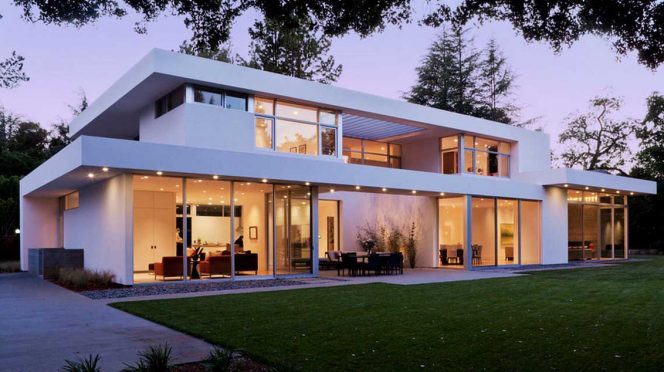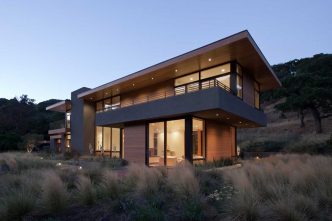Located on the outskirts of a Dutch village and close to the sea, the W.I.N.D. House, designed by UNStudio, is backed by a sheltered wooded area and fronted by a large, open expanse of polder landscape. The design of the house responds to both its setting and to the seasons, whilst regulating and maximising upon the effects of these.

The elevated position of the open plan living areas enhances the views to the exterior. Each of the four facades, curve towards the inside to create four distinct petal-like wings. These curving recesses are visually connected to each other through their view lines, which cross at the heart of the building. The vertical organisation of the building follows a centrifugal split-level principle. An open staircase at the centre of the house connects the front and back wings.

Suggesting the shape of a simple flower, each of the four facades curve towards the inside to create four distinct petal-like wings and to draw the landscape further into the interior. These curving recesses are visually connected to each other through their view lines, which cross at the heart of the building and provide varied diagonal vistas throughout the building. At the front and back the recesses strengthen the inside-outside connection by providing cross views between the wings.

The vertical organisation of the building follows a centrifugal split-level principle. An open staircase at the centre of the house – which forms the circulation core between the four recesses – connects the front and back wings, with the result that each turn on the stair provides expansive vistas through the house and out towards the surrounding landscape.

The entrance level houses basement functions and the carport, which is situated next to the main entrance. From the main entrance the central staircase leads towards the children rooms and the music room on the first floor to the rear of the house. From here it proceeds up to the raised first level at the front of the house, where the main living area and kitchen are located.

From the living areas the staircase leads up to the second level at the rear of the house, where the Master bedroom with hamam and the guest room are located, before ascending further up to the generous roof terrace which covers the complete two front wings of the house and overlooks the polder landscape.

A comprehensive home automation system enables integrated control of the electrical systems including solar panels and mechanical installations. Complete control of this ‘smart home’ is possible by a central touch-screen in the living area, while decentral devices provide dedicated control per room. Furthermore control is possible remotely by independent devices via LAN-connection.

Energy from the sun is harvested by solar panels located on the roof at the back of the house. In addition the integrated sustainability concept of the house consists of a central air/water heat pump for heating and cooling and mechanical ventilation with waste heat recovery. The heat pump provides warmth in the winter and cooling during the summer. Distribution is provided by floor heating and cooling with individual control for each room.

Heat gain is reduced through the use of tinted glass on the fully glazed front and back facades. This coated glazing further enables natural light to flood the interior spaces, whilst increasing privacy during daytime. The walls and ceilings of the house are clad with natural clay stucco and the main walls consist of clay bricks which aid in providing a healthy indoor climate due to the evaporating effect of the clay.

The façade and the roof are clad with wooden slats that occasionally taper in and out, providing a play of varying shadows according to different views, whilst also creating soft openings for secondary windows in the kitchen and bathroom.
Photography by Inga Powilleit & Fedde de Weert














